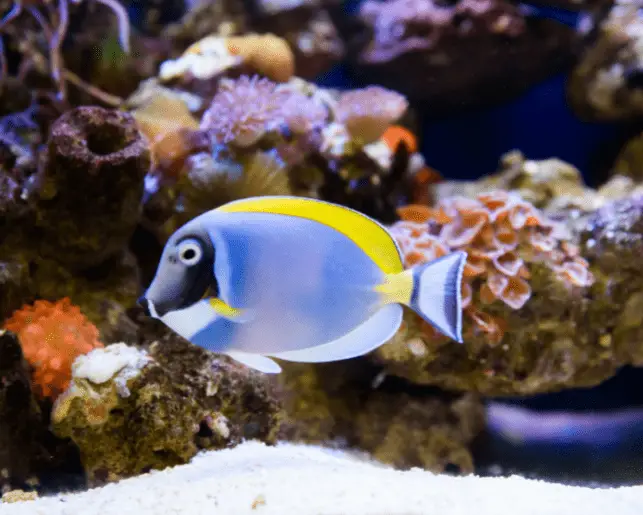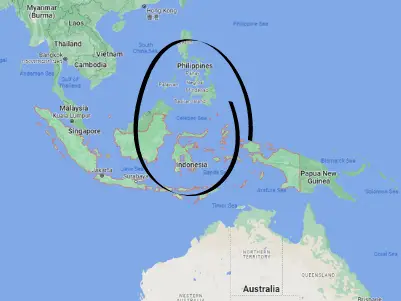Did you know there are well over 30,000 different species of tropical fish identified? This number continues to rise as more species are discovered.
This article will give you a list of our 7 favourite tropical fish beginning with the letter P.
Some you may have heard of, whilst some I am sure you won’t as they are more unusual. We are using their common names, as who actually uses their scientific names when popping into the local pet shop?! I have included the scientific names as well though for the nerdy types.
For the purpose of variation (and because, quite frankly, some of these letters were hard to research and find pictures!), we may have included some saltwater fish as well. These are clearly marked, as rule number 1 in the world of fishkeeping is that you can’t mix your freshwater fish with your saltwater fish.
Tropical Fish that Start with the Letter P.
- Pearl Danio
- Pink-tailed Chalceus
- Paradise Fish
- Pearl Gourami
- Peacock Rainbowfish
- Peter’s Elephantnose
- Powder Blue Tang (saltwater)
Pearl Danio.

Scientific name: Danio albolineatus.
Pearl Danios are known to originate from south east Asia-around the Myanmar, Thailand and Sumatra regions.
They grow up to about 6 cms and show all the traditional characteristics of a danio, which is a very lively, almost skittish, shoaling fish.
They are a lovely iridescent pearl colour, which can look lovely and sparkly in the correct lighting.
They love to swim around the top of the tank in their little gang, so they need a lot of open space for them to be able to do so. Make sure you have a lid on your tank as danios are prolific jumpers, especially if they aren’t happy in their environment.

Pink-tailed Chalceus.

Scientific name: Chalceus ararapeera.
The gorgeous Pink-tailed Chalceus originates from quite a large area, covering Venezuela, French Guyana, Suriname and parts of Colombia.
They can grow up to an impressive 25-30cms when kept in optimum water conditions. They need plenty of space to be able to swim around.
They cannot be kept with anything smaller than they are as the smaller fish will become lunch. They need to be kept in groups of at least 6 as well, as this will reduce any petty arguments between them. This means that you need to have a very big, specialist tank to be able to house them comfortably. They can get quite nervous as well so they need places to hide, for example, plants, driftwood and ornaments.

Paradise Fish.

Scientific name: Macropodus opercularis.
The stunning Paradise Fish originally comes from Eastern Asia-China, Korea, Vietnam and Taiwan regions. They are actually a member of the gourami family, and are also known as a Paradise Gourami.
They can grow up to 11 cms. The males are brighter coloured and grow slightly larger than the females.
They are easily recognisable due to the orange bands that circle their body on a blue background. There is also an albino variation which has the orange bands but on a very pale, almost white background.
They can get quite aggressive if you have more than one male of the species in your tank. They are better being kept in a pair of one male and one female to reduce any trouble. Some experts suggest they are better on their own, in a pair, with no other fish to stop any trouble occurring, as they can get nasty and can rip anything to shreds that they see as a threat.

Pearl Gourami.

Scientific name: Trichopodus leerii.
The Pearl Gourami originates from an area in South-east Asia, covering the Malay Peninsula, Sumatra and Borneo.
They can grow up to around 10cms, and are generally peaceful, although the males can get a bit narky with each other. Having a nice large tank can help reduce any trouble though.
They get their name from the beautiful, pearl-like markings on their body. the males tend to have a reddish colouring on their underside. They also have a distinctive black stripe that runs from their mouth to their tail.
Pearl Gouramis are a labyrinth species so will sometimes come up to the water’s surface for a big gulp of air. This is nothing to worry about.

Peacock Rainbowfish.

Scientific name: Melanotaenia praecox.
The Peacock Rainbowfish originates from New Guinea, within the fast flowing Mamberamo rivers.
They can grow up to around 6 cms, and they are a very peaceful bunch. They are used to fast flowing water so they need to be in a well oxygenated tank. An air pump is always a welcome addition for this breed.
The Peacock Rainbowfish gets its name from their amazing peacock blue colour. Their colour can look even more vivid in a well planted tank. The males always seem to be brighter in colour than the females.
This species of fish are perfect for a community tank as they get along with everyone.

Peter’s Elephantnose.

Scientific name: Gnathonemus petersii.
The brilliantly named Peter’s Elephantnose originates from Africa, mainly Nigeria, Cameroon and the Democratic Republic of the Congo.
The ‘elephant nose’ part of this species is actually their jaw. They put it to good use to dig for food in the muddy waters in their natural habitat. Another skill they possess is to use electrical currents they can produce to help them navigate their way around. Again, this is due to the dark and muddy waters they are used to in the rivers in Africa.
They can grow up to an impressive 20-25 inches, and they do not get on with their own species as they are very territorial.
If you have a tank big enough to house them comfortably, they prefer a dimly lit tank with lots of substrate for them to dig around in.

Powder Blue Tang (saltwater).

Scientific name: Acanthurus Ieucosternon.
The stunning Powder Blue Tang is a saltwater reef fish that originates from islands in the Indonesia and Philippines region. They also are said to have originated from East Africa.
The tangs are the smaller species of the surgeonfish family, although, growing to a potential 20-25cms isn’t that small!
They are, quite simply, a stunning fish to look at. They have a blue body, with a dark blue face, and have a beautiful bright yellow dorsal fin which curves at the top.
The Powder Blue Tang is quite territorial, and is intolerant of its own kind. They are fierce defenders of any algae where they are, as they consume a lot of it in their diet.
They are prone to infection, especially when introduced to a new tank. Even the most experienced fishkeepers can have problems with keeping them healthy.

Related Articles:
Tropical Fish that Start with A

